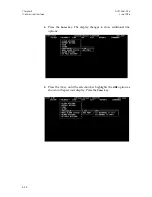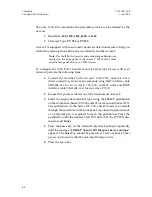
To toggle the exit key from
Esc
to
Tab
, and vice versa, follow these steps:
1.
Select
SYSTEM
from the Main Menu Line.
2.
Select
EXIT KEY
.
3.
Select
ESC
or
TAB
, depending on which key you wish to activate.
4.
Press the
Enter
key.
Network Interface Configuration
Perform the following steps to configure the interface to the T1 network (line):
1.
From the Main Menu Line, select
LINE
.
2.
Move the selection bar to
FRAMING
and press the
Enter
key. Select the
desired framing format (D4 or ESF). Press the
Esc
key.
3.
Move the selection bar to
CODING
and press the
Enter
key. Select the
desired line coding (AMI or B8ZS). Press the
Esc
key.
4. Move the selection bar to
LBO
and press the
Enter
key. Select the
desired line build-out. The telco should provide information about
line build-out requirements. Press the
Esc
key.
5.
Move the selection bar to
T1.403
and press the
Enter
key. If other network
equipment monitors ANSI T1.403 one-second performance reports,
enable them by selecting
ON
. Otherwise, select
OFF
. Press the
Esc
key.
Note:
T1.403
can be enabled only when
FRAMING
=
ESF
.
6. Move the cursor to
YELLOW
and press the
Enter
key
.
To enable
Access-T to generate Yellow Signal on Red Alarm conditions, select
ON
. Otherwise, select
OFF
. Press the
Esc
key.
7. Move the cursor to
DATA LINK ID
and press the
Enter
key
.
If Access-T
functions as the CSU, select
CSU
. If there is an external CSU respond-
ing to ESF data link commands, select
DTE
. (The
DATA LINK ID
option
has no effect if ESF framing mode is not used.) Press the
Esc
key.
8.
Move the cursor to
INBAND
and press the
Enter
key. If Access-T is to
recognize in-band loopback control codes, select
ON
. If Access-T is to
ignore in-band loopback control codes, select
OFF
. (Generally, recog-
nition of in-band codes is desirable in D4 mode, but not desirable in
ESF mode, where FDL commands are available.) Press the
Esc
key.
ACST-0351-005
Chapter 6
June 1996
Configuration Procedures
6-11






























